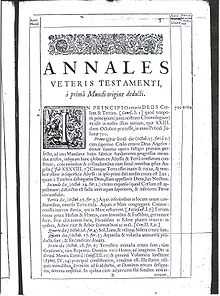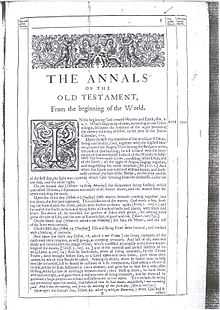Ussher chronology


The Ussher chronology is a 17th-century chronology of the history of the world formulated from a literal reading of the Bible by James Ussher, the Archbishop of Armagh (Church of Ireland). The chronology is sometimes associated with young Earth creationism, which holds that the universe was created only a few millennia ago by God as they believe is described in the first two chapters of the biblical book of Genesis.
The full title of Ussher's work is Annales Veteris Testamenti, a prima mundi origine deducti, una cum rerum Asiaticarum et Aegyptiacarum chronico, a temporis historici principio usque ad Maccabaicorum initia producto. ("Annals of the Old Testament, deduced from the first origins of the world, the chronicle of Asiatic and Egyptian matters together produced from the beginning of historical time up to the beginnings of Maccabes")
Ussher's work was his contribution to the long-running theological debate on the age of the Earth. This was a major concern of many Christian scholars over the centuries.
The chronology is sometimes called the Ussher-Lightfoot chronology because John Lightfoot published a similar chronology in 1642–1644. This, however, is a misnomer, as the chronology is based on Ussher's work alone and not that of Lightfoot. Ussher deduced that the first day of creation began at nightfall on Saturday, October 22, 4004 BC, in the proleptic Julian calendar, near the autumnal equinox. He elsewhere dates the time to 6 pm. Lightfoot similarly deduced that Creation began at nightfall near the autumnal equinox, but in the year 3929 BC.
Ussher's proposed date of 4004 BC differed little from other Biblically based estimates, such as those of Jose ben Halafta (3761 BC), Bede (3952 BC), Ussher's near-contemporary Scaliger (3949 BC), Johannes Kepler (3992 BC) or Sir Isaac Newton (c. 4000 BC).[1] Ussher's specific choice of starting year may have been influenced by the then-widely-held belief that the Earth's potential duration was 6,000 years (4,000 before the birth of Christ and 2,000 after), corresponding to the six days of Creation, on the grounds that "one day is with the Lord as a thousand years, and a thousand years as one day" (2 Peter 3:8). This view continued to be held as recently as AD 2000,[2][3] six thousand years after 4004 BC.
Ussher's methods
The chronologies of Ussher and other biblical scholars corresponded so closely because they used much the same methodology to calculate key events recorded in the Bible. Their task was complicated by the fact that the Bible was compiled from different sources over several centuries with differing versions and lengthy chronological gaps, making it impossible to do a simple totaling of Biblical ages and dates. In his article on Ussher's calendar, James Barr has identified three distinct periods that Ussher and others had to tackle:[4]
- Early times (Creation to Solomon). Ostensibly the easiest period, as the Bible provides an unbroken male lineage from Adam through to Solomon complete with the ages of the individuals involved. However, not all of the versions of the Bible provide the same ages — the Septuagint gives much longer ages, adding about 1500 years to the date of Creation. Ussher resolved this problem by relying on the Hebrew Bible instead.
- Early Age of Kings (Solomon to the destruction of the Temple in Jerusalem and the Babylonian captivity). The lineage breaks down at this point, with only the length of the kings' reigns being provided and a number of overlaps and ambiguities complicating the picture. Ussher had to cross-reference the Biblical records with known dates of other people and rulers to create an overall timeline.
- Late Age of Kings (Ezra and Nehemiah to the birth of Jesus). No information at all is provided in the Bible. Ussher and his counterparts therefore had to try to link a known event from this period with a dateable event in another culture, such as the Chaldeans, Persians or Romans. For instance, the death of the Chaldean King Nebuchadnezzar II (who conquered Jerusalem in 586 BC) could be correlated with the 37th year of the exile of Jehoiachin (2 Kings 25:27).
Using these methods, Ussher was able to establish an unadjusted Creation date of about 4000 BC. He moved it back to 4004 BC to take account of an error perpetrated by Dionysius Exiguus, the founder of the Anno Domini numbering system. Ussher chose 5 BC as Christ's birth year[5] because Josephus indicated that the death of Herod the Great occurred in 4 BC.[6] Jesus could not have been born after that date.
The season in which Creation occurred was the subject of considerable theological debate in Ussher's time. Many scholars proposed it had taken place in the spring, the start of the Babylonian, Chaldean and other cultures' chronologies. Others, including Ussher, thought it more likely that it had occurred in the autumn, largely because that season marked the beginning of the Jewish year.
Ussher further narrowed down the date by using the Jewish calendar to establish Creation as beginning on a Sunday near the autumnal equinox. The day of the week was a backward calculation from the six days of creation with God resting on the seventh, which in the Jewish tradition is Saturday—hence Creation began on a Sunday. The astronomical tables that Ussher probably used were Kepler's Tabulae Rudolphinae (Rudolphine Tables, 1627). Using them, he would have concluded that the equinox occurred on Tuesday October 25, only one day earlier than the traditional day of its creation, on the fourth day of Creation week, Wednesday, along with the Sun, Moon, and stars (Genesis 1:16). Modern equations place the autumnal equinox of 4004 BC on Sunday October 23 Julian.[7] Ussher stated his time of Creation (nightfall[8] preceding October 23) on the first page of Annales in Latin and on the first page of its English translation Annals of the World (1658). The following English quote is based on both, with a serious error in the 1658 English version corrected by referring to the Latin version (calendar → period).
In the beginning God created Heaven and Earth, Gen. 1, v. 1. Which beginning of time, according to our Chronologie, fell upon the entrance of the night preceding the twenty third day of Octob[er] in the year of the Julian [Period] 710. The year before Christ 4004. The Julian Period 710.
Ussher provides a slightly different time in his "Epistle to the Reader" in his Latin and English works:[5] "I deduce that the time from the creation until midnight, January 1, 1 AD was 4003 years, seventy days and six hours." Six hours before midnight would be 6 pm.
Ussher's chronology today
It may be an accident of history that Ussher's chronology remains so well known while those of Scaliger and Bede, amongst others, have slipped into obscurity. From William Lloyd's 1701 edition onwards, annotated editions of the immensely influential King James translation of the Bible began to include his revised chronology with their marginal annotations and cross-references. The first page of Genesis was annotated with Ussher's date of Creation, 4004 BC, though in reality, Ussher's Annales is estimated to have relied on the Bible for only one sixth of its volume. It was included in the widely distributed Scofield Reference Bible. More modern translations of the Bible usually omit the chronology, but there are still many copies of the annotated King James in circulation.
By the end of the 19th century, Ussher's chronology came under increasing attack from supporters of uniformitarianism, who argued that Ussher's "young Earth" was incompatible with the increasingly accepted view of an Earth much more ancient than Ussher's. It became generally accepted that the Earth was tens, perhaps even hundreds of millions of years old. Ussher fell into disrepute among theologians as well; in 1890, Princeton professor William Henry Green wrote a highly influential article in Bibliotheca Sacra entitled "Primeval Chronology" in which he strongly criticised Ussher. He concluded:
We conclude that the Scriptures furnish no data for a chronological computation prior to the life of Abraham; and that the Mosaic records do not fix and were not intended to fix the precise date either of the Flood or of the creation of the world.[9]
The similarly conservative theologian B. B. Warfield reached the same conclusion in "On The Antiquity and Unity of the Human Race",[10] commenting that "it is precarious in the highest degree to draw chronological inferences from genealogical tables".
Nevertheless, Professor James Barr (then Oriel Professor of the interpretation of the Holy Scripture, Oxford University) wrote in 1984:
…probably, so far as I know, there is no professor of Hebrew or Old Testament at any world-class university who does not believe that the writer(s) of Genesis 1–11 intended to convey to their readers the ideas that… the figures contained in the Genesis genealogies provided by simple addition a chronology from the beginning of the world up to later stages in the biblical story…
Archbishop Ussher's chronology has in recent years been subject to artistic criticism, including in the play Inherit the Wind (based on the Scopes Monkey Trial) and the fantasy novel Good Omens which ironically alleges that "he is off by a quarter of an hour". A different viewpoint comes from Stephen Jay Gould, who, while totally disagreeing with Ussher's chronology, nevertheless wrote:[11]
I shall be defending Ussher's chronology as an honorable effort for its time and arguing that our usual ridicule only records a lamentable small-mindedness based on mistaken use of present criteria to judge a distant and different past
Ussher represented the best of scholarship in his time. He was part of a substantial research tradition, a large community of intellectuals working toward a common goal under an accepted methodology…
See also
Notes
- ↑ William W. Hay (2012). Experimenting on a Small Planet: A Scholarly Entertainment. Springer. p. 63. ISBN 9783642285608. Retrieved November 17, 2013.
- ↑ Kenneth G. C. Newport (28 August 2000). Apocalypse and millennium: studies in biblical eisegesis. Cambridge University Press. p. 104. ISBN 978-0-521-77334-8. Retrieved 23 March 2011.
- ↑ Christopher Rowland; John Barton (2002). Apocalyptic in history and tradition. Sheffield Academic Press. pp. 233–252. ISBN 978-0-8264-6208-4. Retrieved 23 March 2011.
- ↑ James Barr, 1984–85 (PDF).
- ↑ 5.0 5.1 James Ussher, "Epistle to the Reader", Annals of the World (2003) page 9.
- ↑ John P. Pratt, "Yet another eclipse for Herod", The Planetarian, vol. 19, no. 4, Dec. 1990, pp. 8–14.
- ↑ Calendrica The position of the Sun at the autumnal equinox is 180°, where 0° is its position at the vernal equinox.
- ↑ Nightfall occurs when three medium-sized stars become visible about a half hour after sunset. This is a Jewish term describing the beginning of the Sabbath on Friday evening.
- ↑ Primeval Chronology
- ↑ Princeton Theological Review, 1911
- ↑ Stephen Jay Gould, 1993. "Fall in the House of Ussher" in Eight Little Piggies (Penguin Books)
References
- Ussher, J, 1650. Annals of the World: James Ussher's Classic Survey of World History ISBN 0-89051-360-0 (Modern English republication, ed. Larry and Marion Pierce, Green Forest, AR: Master Books, 2003)
- Ussher, J, 1650. "The Annals of the World". Retrieved 12 October 2014.
- James Barr, 1984–85. "Why the World Was Created in 4004 BC: Archbishop Ussher and Biblical Chronology", Bulletin of the John Rylands University Library of Manchester 67:575–608
- William R. Brice, 1982. "Bishop Ussher, John Lightfoot and the Age of Creation", Journal of Geological Education 30:18–24.
- Stephen Jay Gould, 1993. "Fall in the House of Ussher" in Eight Little Piggies (Penguin Books)
- Bishop Ussher Dates the World: 4004 BC
- John Lightfoot, The Whole Works of the Rev. John Lightfoot, D. D., 13 vols., 1822–25.
| ||||||||||||||||||||||